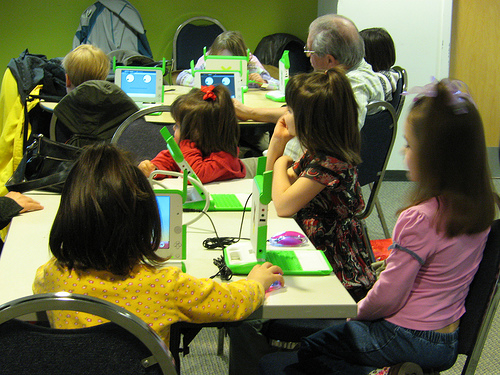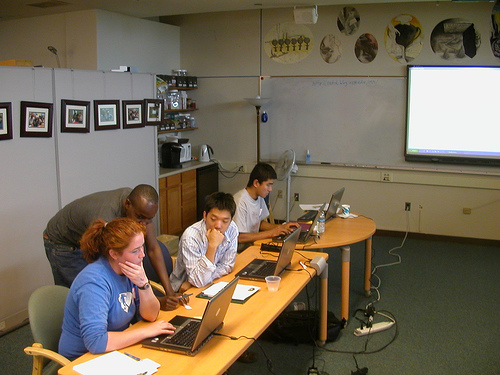Why Schools Should Switch To Kindle E-Readers
 In October of 2009 USA today released an article discussing Cushing Academy in Massachusetts and the school library’s decision to rely upon the Amazon.com Kindle e-reader for almost all of their book circulation needs. While this is the first major coverage of an almost full conversion to digital readers for a school library, more and more school libraries have begun to utilize Kindle devices in some capacity.
In October of 2009 USA today released an article discussing Cushing Academy in Massachusetts and the school library’s decision to rely upon the Amazon.com Kindle e-reader for almost all of their book circulation needs. While this is the first major coverage of an almost full conversion to digital readers for a school library, more and more school libraries have begun to utilize Kindle devices in some capacity.
In many cases, one of the primary complaints of parents, teachers, and librarians not in favor of the Kindle being implemented in school libraries is that it is a somewhat expensive device with an average price tag of approximately $260-$470 depending on the model purchased. While this may seem like an inordinately huge price tag for an educational library to pay for a new piece of equipment, it is important to consider other variables.
One new hardcover book, in particular a non-fiction title, is usually going to cost a school library $20-$30 if a standard hardcover is purchased. Should a library edition of available titles be purchased, the cost increases. Almost all new books and bestsellers cost only $9.99 on the kindle, which equates to a $10 to $20 savings per book. A school library that purchases 20 books in a month will instantly pocket the cost of a Kindle unit in savings and will only have to purchase the book once to have it instantly available in the library’s kindle account.
An added bonus that comes with switching over to a Kindle based library is that it does not have to be limited purely to the number of handheld devices owned by the school or school system. Kindle now has a reader for PCs and a Kindle reader application for iPhones and the iPod Touch. Each of these applications allows a Kindle owner the ability to read a book in their Kindle account when they do not have access to their Kindle unit.
Any notes or highlighted sections will automatically synchronize and be visible on the PC and/or iPhone screen. This option could be particularly useful in literature classes where book selections are read both independently and in the classroom. A student who takes notes on a school library provided Kindle device during class can access those same notes at home on their PC in preparation for a test. Future upgrades to the Kindle and iPhone readers aim to allow the addition of notes to the PC and iPhone books as well.
As Kindle technology continues to develop, it will surely offer many more features targeted towards school and public libraries. Whether it is a full or partial implementation, e-readers should have a place in any technologically advanced educational system and the individual school libraries within them.
Image by http://www.flickr.com/photos/jcwestbrook/ / CC BY-ND 2.0
Applications Of Wikis In The Classroom
There are few students with access to computers who have not utilized a Wiki in o ne form or another. Wikipedia.org’s editable encyclopedia has become a go to source for millions of people looking for quick and current information on a variety of topics while other Wiki applications such as Wetpaint and MediaWiki have opened up the doors for even more community input and creation within the Wiki universe.
ne form or another. Wikipedia.org’s editable encyclopedia has become a go to source for millions of people looking for quick and current information on a variety of topics while other Wiki applications such as Wetpaint and MediaWiki have opened up the doors for even more community input and creation within the Wiki universe.
When it comes to education, Wikipedia.org can be an invaluable tool for a student. While many teachers and schools do not accept Wikipedia as a valid source for school papers or reports due to its editable nature, many Wikipedia pages contain an extensive source or footnotes section of their own which contains links to the URLs where the initial reporting or information can be found. A student doing a research paper on the President or a movie star can use the Wikipedia page as a starting point to fan out to other resources that are easily attributed and 100% school approved.
Wiki technology can also be found at Wetpaint.com which is a website that allows anyone to create their own editable wikis around a topic. Wetpaint provides a domain and the tools needed to have the equivalent of a virtual bulletin board for a classroom. Since these wikis can be adjusted to a private setting that allows access by invitation only, they are a safe way for students to mingle and discuss class relevant topics when away from school.
Pictures and files can be uploaded to Wetpaint, and videos from YouTube can be embedded within a page, making the wikis created on Wetpaint.com perfect for classes that require a lot of visuals such as art, history, and science! The Wetpaint site is also a very good venue for classes with numerous examples of printouts or take home materials such as vocabulary lists or worksheets. These materials can be uploaded to the class site, and then accessed by the student from home.
For schools that have the required servers for operating MediaWiki, an even more advanced option for content creation exists. MediaWiki is a free software application that allows users to create a full Wiki that will greatly resemble Wikipedia.org and the MediaWiki site in terms of appearance and user driven editing. Secondary schools with more advanced computer courses could even consider a collaborative venture on a MediaWiki to be a group or class wide project during a term. A school with a rich history and several different departments may also wish to create a school specific Wiki.
As the demands of providing a well-rounded education increase, so will the capabilities and reach of Wikis. Considering the lack of cost involved in accessing these materials coupled with the benefits they provide to educators and students, Wiki technology can be a perfect fit for many classrooms.
Questions Every School Administrator Should Ask Before Investing in a Technology Solution
“Integrating technology throughout a school system is, in itself, significant systemic reform. We have a wealth of evidence attesting to the importance of leadership in implementing and sustaining systemic reform in schools. It is critical, therefore, that we attend seriously to leadership for technology in schools.” – Don Knezek, Director of the Technology Standards for School Administrators (TSSA) Collaborative
While technology can often be a positive so urce for increased efficiency and productivity in schools, today’s administrators are faced with a barrage of options to choose from. Making the wrong choice when it comes to technology can not only be expensive but result in many hours of work invested for little gain – or worse.
urce for increased efficiency and productivity in schools, today’s administrators are faced with a barrage of options to choose from. Making the wrong choice when it comes to technology can not only be expensive but result in many hours of work invested for little gain – or worse.
Below is a list of fundamental questions each school administrator should consider before investing precious human and financial resources in implementing a technology solution:
What benefits – in time, money, efficiency — are we seeking to gain from implementing this solution?
All too often, organizations will invest in a solution because of a misplaced notion that “they have to” or “everyone else is.” If a solution ultimately doesn’t save you time, reduce expenses or increase efficiency – is it really worth it?
How much will it cost to implement? What is our return on investment?
In today’s economy, schools are more concerned than ever with managing their finances. When evaluating cost, school administrators should look not only at how much it costs to purchase a technology solution but the related implementation and on-going costs of training, support, upgrades, etc.
How well does this solution integrate with our current system and our school’s culture?
A school district invests hundreds of thousands of dollars in a state of the art PC-based computer lab only to find that a majority of students and faculty own Macs. Doing a thorough analysis and survey of what technology and systems are currently used can help schools avoid implementing solutions that ultimately end up collecting dust in a corner. After all, a solution is only as good as how well and how often it is used. In addition to evaluating the effectiveness and usage of technology systems, infrastructures and standards that are currently in place on campus, administrators should also consider what technologies and standards are being used by teachers, students, parents and other stakeholders outside of school.
Is this solution scalable and can it meet future needs?
Implementing a new technology solution takes time, money and resources – so it is important to make sure that you invest in a solution that not only meets current requirements but can easily be scaled or adapted to meet future needs. Costs for additional licensing, ease of customization, additional modules, etc. are all elements that should be considered when evaluating a solution’s scalability.
Photo by http://www.flickr.com/photos/curiouslee/ / CC BY 2.0
7 School Tools For Making Your School More Digital
Students growing up in the digital ag e are likely to engage with digital technology in more and more aspects of their life. Part of the role of schools is to prepare students for the rapidly changing world which is quickly becoming more digital every day as new tools emerge to replace things that traditionally didn’t require the use of computers. Here are 7 tools that schools can use to become more digital.
e are likely to engage with digital technology in more and more aspects of their life. Part of the role of schools is to prepare students for the rapidly changing world which is quickly becoming more digital every day as new tools emerge to replace things that traditionally didn’t require the use of computers. Here are 7 tools that schools can use to become more digital.
1. Microblogging
Twitter, has become a popular new communication tool that can be really useful if used the right way. Many teachers, school administrators, and others share valuable information on Twitter via 140 character “Tweets”. One of the most important aspects of Twitter is its integration with SMS, so that users of Twitter can receive messages from people they follow on their cell phones, which almost all teachers, students, and parents carry with them. A principal of a school can send out important messages which can be received by all followers. Twitter also makes it easy to send direct messages to individuals that will be sent to their cell phone as well as their Twitter account that can viewed in a browser.
2. Online school calendars
Calendars are a tool that been used for thousands of years and an online version of the calendar can make calendars more useful. Online school calendars can be accessed from any computer with an internet browser and can be updated in real time when changes occur. This is a major upgrade from a paper based calendar that is usually in one location and can only be updated when a new calendar is printed out and sent out. An online calendar can also provide much greater detailed information, help organize and manage all the schools events, send information to external personal calendars, and many more things that paper calendars can not do.
3. Social networks
Social networks allow for effective communication between groups of individuals online. Facebook for instance allows the creation of groups where individuals can post information, have group discussions, or interact with each other. Yes, there are opportunities for wasting time, but these are outweighed by the benefits of the facilitation of collaboration and communication. Schools can even create their own social networks using tools like Ning.
4. Blogging
Blogging has democratized the publishing of content so that now anyone can write and publish content that will be read by as many people who are interested. Many teachers write blogs to discuss issues in education, share useful educational resources, or engage with students and parents. Students can improve their writing skills by creating their own blogs about topics that they care about. Some free tools that help easily create and publish blogs are Blogger, Edublogs, and WordPress.com.
5. Digital books
There are many advantages of switching to a digital format for books. A digital text book or book is much lighter to carry, which reduces the heavy weight many students carry on their backs. They can be updated more frequently and less expensively when information changes. Digital content also tends to be less expensive, as it reduces the publishers costs to distribute. Many classic books are available for free in digital format. One school has even replaced their entire library with a set of Kindles.
Digital books can be read on laptops, the iPod touch, netbooks, or eReaders like the Kindle or Nook. With the Kindle, students can get access to almost any book in about a minute as well as preview a vast library. The Nook allows a sharing feature so books can be shared between devices for a limited time for certain titles.
6. Wikis
Most people know about Wikipedia, the community driven encyclopedia, but Wikis also have tremendous potential as a collaboration tool. Sites like WetPaint allow you to create a free wiki for your school, a school project, etc. Users can add, edit, or view content to these wikis which can be great for collaboration and sharing information.
7. Online Video/ Podcasts
Students have unprecedented opportunity to broadcast their ideas and creativity by creating videos or audio recordings and publishing them for free on sites like YouTube or Podbean for audio. Students can produce shows, movies, or speeches that can be distributed to a worldwide audience. Some students created a rap video about math that has received over 3 million views. Using Ustream, teachers could broadcast a live recording of a lecture. There are also tons of free online lectures from top universities covering various subjects that are available at Academic Earth, YouTube, and iTunesU.
Can you think of additional tools to add to this list?
Photo by http://www.flickr.com/photos/zappowbang/ / CC BY 2.0
4 Reasons To Switch To An Internet School Calendar
There are many reasons why schools should make the switch to internet calendars from the traditional paper-based model. According to Tech Crunch “while more and more schools are turning to the web as a platform, less than 5% of schools, both public and private, are offering parents internet school calendars.”
1. Help communicate more effectively through digital tools
As more mobile devices gain internet connectivity, the internet is becoming more ubiquitous in our normal everyday activities. School communication can be amplified through digital tools like an internet school calendar that can be accessed from virtually anywhere that the internet is available. This allows students and parents to bring their school calendars everywhere they go and receive valuable school information in real time.
2. Reduce carbon footprint/save paper
One of the main sources of waste in schools was traditionally the printing of information. The distribution of important school information often required the printing of massive amounts of documents -monthly calendars, fliers, etc.. An internet school calender can eliminate the need to print documents and save a significant amount of paper and ink, which not only reduces the carbon footprint but costs as well (ink can cost thousands of dollars per gallon).
3. Encourage greater involvement of students and parents
There is little doubt that schools that are able to better engage their students, parents, and communities, will have better educational outcomes. Students who are engaged with after school activities improve their chances of getting into the college of their choice, and parents who are involved in school activities help student success. An internet school calendar can encourage engagement by providing information on school activities to make it easier to participate.
4. Reduce workload of school staff
Administrators who have switched to an internet school calendar often report a significant reduction of parent phone calls to the office. When school scheduling and event information is published to a central and updated location, like an internet school calendar, parents do not need to call the office for information.
Managing events for an entire school of up to thousands of students can be a monumental task. School event scheduling software like Tandem for Schools can make this task much easier with a streamlined facilities request system, automatic conflict checking, and simple publishing of events.
Learn more about switching to an internet school calendar. Schedule a free online demonstration of Tandem for Schools on your own computer.
If you are a parent and would like to support internet school calendars, you can suggest that your school consider switching at SchoolCal.org.
Using Blogs In the Classroom
In blogs, educ ators are discovering a new tool for engaging students who live in a world increasingly dominated by technology. By incorporating blogging into the school environment, educators can capitalize on the social media explosion, turning a potentially isolating medium into a window of discovery and self-expression as well as a bridge to the broader learning community.
ators are discovering a new tool for engaging students who live in a world increasingly dominated by technology. By incorporating blogging into the school environment, educators can capitalize on the social media explosion, turning a potentially isolating medium into a window of discovery and self-expression as well as a bridge to the broader learning community.
Naturally when confronted with change there will be some resistance among educators to adopt and embrace this new medium, just as the advent of the internet posed a classroom challenge. Yet the reality is that today’s students are already immersed in social media and schools can either seize this new opportunity or play the proverbial ostrich. Ideally educators will lead and not lag behind at this transformative moment by encouraging youth to utilize this amazing technology as more than just an entertaining diversion.
Subscription services like EdublogsCampus, based on the WordPress platform, provide the technical framework and support to get schools started. Luckily for educators, tech-savvy students make excellent navigators, and engaging their help fosters a spirit of cooperation and sense of mastery. Classroom blogs can serve any number of purposes, as student newspaper, sharing information, writing practice, homework submission and testing forum, tracking tool for parents, online calendar, and so on. Security is of course a key concern, and web-hosting services offer custom access levels to assure student safety and confidentiality.
Blogging is a natural for facilitating extension of lessons, replacing old norms of information regurgitation and bringing lessons to life through interactivity, journaling and use of multi-media. Blogging provides the ideal avenue for sharing the learning experience, furnishing a vehicle for budding photographers, poets and artists to share their talent in a non-threatening forum. Blogs offer a creative outlet and give students a voice in what may be their only outlet or experience of being heard.
Beginning at the earliest school level, introducing blogs into the classroom fosters an environment of cooperation and recognition of the talents of each individual. At the same time, students are learning and applying technical and communication skills that they will take into the workplace, fulfilling the ideal of learning as an ongoing process and lifelong journey.
Using Facebook In Education
While the thought of Facebook as a learni ng tool might elicit some skepticism, savvy students are discovering uses for the ubiquitous social media site beyond trading gossip and playing games. In fact, Facebook offers an array of applications geared to student needs. Web tools like Do Research 4 Me, Wikiseek Search, and JSTOR Search take the tedium and legwork out of researching term papers. Applications are available for homework assistance, forming virtual study groups, finding the best deals on textbooks, and of course Rate My Professors.
ng tool might elicit some skepticism, savvy students are discovering uses for the ubiquitous social media site beyond trading gossip and playing games. In fact, Facebook offers an array of applications geared to student needs. Web tools like Do Research 4 Me, Wikiseek Search, and JSTOR Search take the tedium and legwork out of researching term papers. Applications are available for homework assistance, forming virtual study groups, finding the best deals on textbooks, and of course Rate My Professors.
Teachers are getting aboard the Facebook bandwagon and establishing accounts of their own, finding it an effective bridge beyond the classroom, freeing them of late night calls from frantic pupils and parents seeking last-minute information on the week’s spelling words or a project due the next day. Facebook also fills a crucial gap as a forum for providing homework guidance and lesson-extending tutorials that may be lacking for latch-key kids. When Facebook is integrated into the learning environment, it helps create a safe online community that parents can feel confident about.
Facebook even provides opportunities for parent involvement through online interaction in a platform that is flexible enough to fit even the busiest schedule. As a conduit for communication it helps build teacher-student-parent relationships beyond the constraints of classroom walls and school schedules, and it does so in a way that is non-intrusive and non-threatening. A parent who dreads the idea of attending a parent-teacher conference after a long day of work and putting a meal on the family table is likely to relish being able to conduct a meeting at their fingertips. In this manner, Facebook creates new opportunities for dialogue between teachers, parents and students, spanning generational, geographic, and cultural distances. When students see that teachers are willing to “speak their language” and use the tools of their generation, amazing connections can occur.
Do you think Facebook has a role in education? Leave your comments below.
E-Readers in Education
 Within a relatively short time frame, Amazon.com launched the Kindle followed by Kindle 2 and Sony launched its latest electronic reader. On the heels of these two revolutionary e-readers, Barnes & Noble will be releasing Nook, their version of an electronic book. Unlike e-readers of the past, these new models offer many features that have school systems and some education advocates pondering whether Kindles or other e-readers should be incorporated into the classroom either in place of or as a supplement to traditional textbooks.
Within a relatively short time frame, Amazon.com launched the Kindle followed by Kindle 2 and Sony launched its latest electronic reader. On the heels of these two revolutionary e-readers, Barnes & Noble will be releasing Nook, their version of an electronic book. Unlike e-readers of the past, these new models offer many features that have school systems and some education advocates pondering whether Kindles or other e-readers should be incorporated into the classroom either in place of or as a supplement to traditional textbooks.
E-Readers offer numerous benefits when incorporated into a classroom setting or an entire educational system. These benefits range from economics to quality of learning and are far reaching enough to demand an audience.
In terms of finances, a standard e-reader will run between $200-300 at current prices. In a public school system, students are typically issued at least six textbooks (math, grammar, literature, science, social studies, an elective, and the potential seventh alternate – health) per year. At an average cost of $75-$100 per new textbook, the e-Reader (even after books were purchased and loaded) would be a comparable price and certainly no more expensive.
A major benefit of using an e-reader in the classroom shines through when one considers the publication date of textbooks. In many schools most textbooks are used for several years in a row. As physical books they cannot be updated and are used even after they are no longer current or are out of date altogether. If e-readers were utilized the books could be updated electronically as new editions were available and cutting edge scientific discoveries or important current events could be studied through publisher provided enhancements.
Another advantage shows up under the heading of note taking. In primary education, students are typically not allowed to write in books or highlight within the text and instead rely on taking pen and paper notes referencing particular passages to study or vocabulary words to look up. With an e-reader, pen and paper notes can become obsolete as a student can digitally underline or highlight important passages and use marginal notations to add supplemental information provided during lectures. Since personalized notes can be stored in a “cloud” provided by the e-Reader manufacturer, if a device malfunctioned this material could be restored. A student could rest assured they would maintain all of their notes from the beginning of a school course to the end within their e-textbook.
E-Readers take nothing from the current educational system but stand to add a lot to the learning experience. In terms of portability, value, and capability, e-Readers could be the next necessity in the classroom and the educational system at large.
Photo credit http://www.flickr.com/photos/ivyfield/ / CC BY 2.0
Using Technology To Build School Communities
If your school leadership is interested in building a larger and stronger community around your school, there are many online tools that can help.
Facebook
Facebook is the largest social network in the world with over 300 million active users and growing. Students have widely adopted Facebook as a tool to communicate with their friends, while the 35 and over age group is the fastest growing group on Facebook. A Facebook group for your school can be a place where students and parents can go to connect with other members of the community. Facebook groups also have a discussion board where members of the community can discuss topics.
Tandem
Tandem for Schools is an online school calendar that displays all the school’s events in one place. Parents and students can go to the real time online calendar to find out what events are going on, which increases participation. For instance, if parents know when and where PTSA meetings are being held, it is much easier to plan on attending. It also helps students find out about clubs that are meeting so they can participate in the extracurricular events they are interested in. When parents and students are more involved in school activities, it strengthens the school community.

Blogs
Blogs, which originated as online journals, have become powerful communication tools which can also be used by schools to build community. For instance teachers typically have a distant relationship with parents. They may talk a couple times a year at a parent-student conference. However, this is an important relationship that can be developed through online social tools like a blog. A teacher can post on their blog to explain what concepts they are studying, what students should be working on, and how parents can help. Parents can post comments on the blog posts, to provide feedback or discuss topics.
Twitter
Twitter, like many of the other tools, is a one to many communication tool. A principal can send a Tweet that will be read by parents, teachers, and students. It can also build community because of the retweet feature. Say you are following the principal who retweets (RT) a message by the PTSA (parent teacher student association) that they need volunteers. Followers of the principal can now follow the PTSA’s tweets and a new connection is created in the community. Twitter is most useful via SMS on your cellphone, where you can follow what people are talking about in your community and join the conversation, even if you are away from your computer.
Will Textbooks Be Replaced By Digital Media?
The following article from Open Education discusses whether textbooks are becoming less relevant in education due to advances in digital media.
Ther e was a large touch of irony in an August NY Times post discussing the demise of a fixture in the world of education, the school textbook. The article, In a Digital Future, Textbooks Are History, predicts the death of an industry that is becoming “antiquated” with each passing tech innovation.
e was a large touch of irony in an August NY Times post discussing the demise of a fixture in the world of education, the school textbook. The article, In a Digital Future, Textbooks Are History, predicts the death of an industry that is becoming “antiquated” with each passing tech innovation.
Though always considered exceedingly expensive, textbooks were once considered as fundamental to the classroom learning experience as the teacher. These tombs were the source of knowledge, the drivers of curriculum, and the teacher’s most important resource.
But all that has changed in the digital world. According to experts, there are two critical factors.
First, there is the assessment of the value (learning produced per dollar) of these texts:
Dollars in the books, isolated on white background, business tra“They are expensive,” writes Seth Godin. “$50 is the low end, $200 is more typical.”
Yet,
“Textbooks have very little narrative,” writes Godin. “They don’t take you from a place of ignorance to a place of insight. Instead, even the best … textbooks surround you with a fairly non-connected series of vocabulary words, oversimplified problems and random examples.”
And of course, in today’s lightening-fast world, they are out of date before the ink is even dry.
Second, while the books are essentially considered less than ideal, we are seeing an enormous change in students based on the fact they have grown up with technology. From the NY Times:
“Kids are wired differently these days,” said Sheryl R. Abshire, chief technology officer for the Calcasieu Parish school system in Lake Charles, La. “They’re digitally nimble. They multitask, transpose and extrapolate. And they think of knowledge as infinite.
“They don’t engage with textbooks that are finite, linear and rote,” Dr. Abshire continued. “Teachers need digital resources to find those documents, those blogs, those wikis that get them beyond the plain vanilla curriculum in the textbooks.”
Beyond Textbooks
Today we offer a Q & A with Andy Chlup of the Vail School District. With experience as a classroom teacher and technology coordinator, Andy is a perfect choice to head up one of the digital learning movements cited in the aforementioned NY Times article, Beyond Textbooks.
Andy notes he has been passionate about utilizing technology in the classroom from the first day he walked into a classroom. His interest in digital learning was spurred on by the wide-spread availability of open-source web-based tools such as WordPressMU, Moodle, DekiWiki, and many more.
Below, Andy discusses the move to a digital learning model, one that actually transcends any discussion of textbooks.
What would you categorize as the three biggest advantages to moving away from textbooks and replacing that tradition with a digital learning model?
- Instant updates. Our superintendent, Calvin Baker, proudly sent out an email message to the school board when Pluto was demoted. In the message he said, we are one of the only districts in the country who’s textbooks are not obsolete.
- Collaboration. At this phase the primary collaboration is happening between teachers but as the tools become more familiar students will be working with each other, their teachers, and the community more and more.
- Costs. While the technology that enables digital learning still costs slightly more than a set of textbooks, it can do so much more. A digital device provides access to content and gives students a platform to create, share, and work.
You can see the full interview with Andy Chlup over at Open Education.
Photo credit:http://www.flickr.com/photos/gingerblokey/ / CC BY-SA 2.0